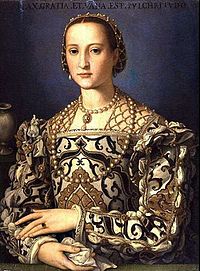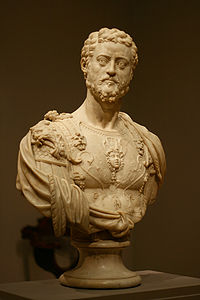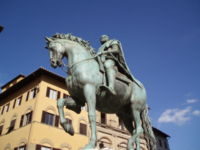- Cosimo I de' Medici, Grand Duke of Tuscany
-
This article is about the Grand Duke of Tuscany. For the founder of the Medici dynasty, see Cosimo de' Medici.
Cosimo I de' Medici Duke of Florence — Grand Duke of Tuscany Cosimo I de' Medici in Armour by Agnolo Bronzino. Spouse Eleanor of Toledo
Camilla MartelliIssue Bia de' Medici
Maria de' Medici
Francesco, Grand Duke of Tuscany
Isabella, Duchess of Bracciano
Cardinal Giovanni
Lucrezia, Duchess of Modena
Prince Garzia
Ferdinando, Grand Duke of Tuscany
Anna de' Medici
Prince Pietro
Virginia, Duchess of ModenaHouse Medici Father Giovanni dalle Bande Nere Mother Maria Salviati Born 12 June 1519
Florence, Republic of FlorenceDied 21 April 1574 (aged 54)
Florence, Grand Duchy of TuscanyCosimo I de' Medici (12 June 1519 – 21 April 1574) was Duke of Florence from 1537 to 1574, reigning as the first Grand Duke of Tuscany from 1569.
Contents
Biography
Cosimo was born in Florence, on June 12, 1519, the son of the famous condottiere Giovanni dalle Bande Nere from Forlì and Maria Salviati. Cosimo came to power at 17, when the 26 year old Duke, Alessandro de' Medici, was assassinated in 1537, as Alessandro's only male child was illegitimate. Cosimo was from a different branch of the family, and so far had lived in Mugello, and was almost unknown in Florence: however, many of the influential men in the city favored him, several of them hoping to rule through him and thereby enrich themselves at the state's expense. However, as Benedetto Varchi famously put it "The innkeeper's reckoning was different from the glutton's." [1] Cosimo proved strong-willed, astute and ambitious, and soon rejected the clause he had signed, which entrusted much of the power to a council of Forty-Eight.
 Portrait said to be of Cosimo I de' Medici, as a boy, attributed to Titian, in the Grand Salon of the Château de Cheverny, in France.
Portrait said to be of Cosimo I de' Medici, as a boy, attributed to Titian, in the Grand Salon of the Château de Cheverny, in France.
When the Florentine exiles heard of the death of Alessandro, they marshalled their forces with support from France and from disgruntled neighbors of Florence. During this time, Cosimo had an illegitimate daughter, Bia (1537 – 1542), who was portrayed shortly before her premature death in a marvelous painting[2] by Bronzino.
Toward the end of July 1537, the exiles marched into Tuscany under the leadership of Bernardo Salviati and Piero Strozzi. When Cosimo heard of their approach, he sent his best troops under Alessandro Vitelli to engage the enemy, which they did at Montemurlo, a fortress that belonged to the Nerli. After defeating the exiles' army, Vitelli stormed the fortress, where Strozzi and a few of his companions had retreated to safety. It fell after only a few hours, and Cosimo celebrated his first victory. The prominent prisoners were subsequently beheaded on the Piazza or in the Bargello. Filippo Strozzi's body was found with a bloody sword next to it and a note quoting Virgil, but many believe that his suicide was faked.
In June 1537 Cosimo was recognized as head of the Florentine state by the Holy Roman Emperor Charles V, in exchange for help against France in the course of the Italian Wars. With this move he firmly restored the power of the Medici, who thereafter ruled Florence until the death of the last of the Medici, Gian Gastone de' Medici, in 1737. The help granted to Charles V allowed him to free Tuscany from the Imperial garrisons, and to increase as much as possible its independence from the overwhelming Spanish influence in Italy.
Cosimo next turned on Siena. With the support of the Emperor, he defeated the Sienese at the Battle of Marciano (1554), and laid siege to Siena. Despite the inhabitants' desperate resistance, on April 17, 1555, after a 15-month siege, the city fell, its population diminished from forty thousand to eight thousand. In 1559 Montalcino, the last redoubt of Sienese independence, was annexed to Cosimo's territories. In 1569, Pope Pius V elevated him to the position of Grand Duke of Tuscany.
Cosimo was an authoritarian ruler and secured his position by employing a guard of Swiss mercenaries. In 1548 he managed to have his relative Lorenzino, the last Medici claimant to Florence, assassinated in Venice.
Cosimo also was an active builder of military structures,[3] in an attempt to save his state from the frequent passage of foreign armies (examples are the new fortresses of Siena, Arezzo, Sansepolcro, the new walls of Pisa and Fivizzano, and the strongholds of Portoferraio, on the island of Elba, and Terra del Sole).
He laid heavy tax burdens on his subjects. Despite his economic difficulties, he was a lavish patron of the arts and also developed the Florentine navy, which eventually took part in the Battle of Lepanto, and which he entrusted to his new creation, the military Order of St. Stephen.
In the last 10 years of his reign, struck by the death of two of his sons by malaria, Cosimo gave up the active rule to his son and successor Francesco I de' Medici, Grand Duke of Tuscany. He retreated to live in his villa, Villa di Castello, outside Florence.
Cosimo and the arts
Cosimo is perhaps best known today for the creation of the Uffizi ("offices"). Originally intended as a means of consolidating his administrative control of the various committees, agencies, and guilds established in Florence's Republican past, it now houses one of the world's most important collections of art, much of it commissioned and/or owned by various Medici. He also finished the Pitti Palace as a home for the Medici and created the magnificent Boboli Gardens behind the Pitti. As his more prominent ancestors had been, he was also an important patron of the arts, supporting, among others, Vasari, Cellini, Pontormo, Bronzino, the architect Lanci, and the historians Scipione Ammirato and Benedetto Varchi.
A large bronze equestrian statue of Cosimo I by Giambologna, erected in 1598, still stands today in the Piazza della Signoria, the main square of Florence.
Cosimo was also an enthusiast of alchemy, a passion he had inherited from his grandmother Caterina Sforza.
Marriage and family
 Eleonora of Toledo, Duchess of Florence, who purchased the Palazzo Pitti in 1549 for the Medici family.
Eleonora of Toledo, Duchess of Florence, who purchased the Palazzo Pitti in 1549 for the Medici family.
In 1539, he married Eleonora di Toledo (1522 – 1562), the daughter of Don Pedro Álvarez de Toledo, the Spanish viceroy of Naples. Her face is still familiar to many because of her solemn and distant portraits by Agnolo Bronzino. The most famous of them, with her son Giovanni, hangs in the Uffizi Gallery. She provided the Medici with the Pitti Palace and seven sons to ensure male succession and four daughters to connect the Medici with noble and ruling houses in Italy. She was a patron of the new Jesuit order, and her private chapel in the Palazzo Vecchio was decorated by Bronzino, who had originally arrived in Florence to provide festive decor for her wedding. She died, with her sons Giovanni and Garzia, in 1562, when she was only forty; all three of them were struck down by malaria while traveling to Pisa.
Before his first marriage, Cosimo fathered an illegitimate daughter with an unknown woman:
- Bia de' Medici (ca. 1536 – March 1, 1542)
With Eleonora, Cosimo fathered eleven children:[4]
- Maria (April 3, 1540 – November 19, 1557)
- Francesco (March 25, 1541 – October 19, 1587)
Cosimo's successor as Grand Duke of Tuscany - Isabella (August 31, 1542 – July 16, 1576)
was murdered by her husband Paolo Giordano I Orsini because of infidelity - Giovanni (September 28, 1543 – November 1562)
became Bishop of Pisa and cardinal - Lucrezia (June 7, 1545 – April 21, 1561)
in 1560 married of Alfonso II d'Este, Duke of Ferrara and Modena - Pietro (Pedricco) (August 10, 1546 – June 10, 1547)
- Garzia (July 5, 1547 – December 12, 1562)
- Antonio (1548 – 1548)
- Ferdinando (July 30, 1549 – February 17, 1609)
Francesco's successor as Grand Duke of Tuscany - Anna (1553 – 1553)
- Don Pietro de' Medici (June 3, 1554 – April 25, 1604)
murdered his wife Eleonora di Garzia di Toledo because of infidelity
After Eleonora's death in 1562, Cosimo fathered two children with his mistress Eleonora degli Albrizzi:
- unnamed daughter (born and died 1566)
died before baptism - Giovanni (1567 – 1621)
later legitimized by his father
In 1570, Cosimo married Camilla Martelli (died 1590) and fathered one child with her:[5]
- Virginia (May 29, 1568 – January 15, 1615)
married Cesare d'Este, Duke of Modena
Ancestors and Descendants
Cosimo I de' Medici, Grand duke of Tuscany ancestors in three generations
Pierfrancesco di Lorenzo de' Medici Giovanni de' Medici il Popolano Laudomia Acciaiuoli Giovanni dalle Bande Nere Galeazzo Maria Sforza Caterina Sforza Lucrezia Landriani Cosimo I de' Medici Giovanni Salviati Jacopo Salviati Maddalena Gondi Maria Salviati Lorenzo de' Medici Lucrezia de' Medici Clarice Orsini - "Ancestors of Cosimo I de' Medici, Duke of Florence", from Foundation for Medieval Genealogy
- Pictorial version of Cosimo I de Medici's Ancestors
- Descendants of Cosimo I de' Medici which maps how the Medici became part of the European Royal families, eventually leading to Prince William, Duke of Cambridge, future King of Great Britain through the House of Stuart.
See also
- Grand Duchy of Tuscany
- Italian War of 1551-1559
- Italian Wars
References
- ^ "Ma un conto facea il ghiotto, e un altro il taverniere", B. Varchi, Storia Fiorentina.
- ^ Bia's portrait by Bronzino, now at the Uffizi Gallery
- ^ Role, R.E., Fort 2008 (Fortress Study Group), (36), pp108-129
- ^ Cosimo's children
- ^ Medici.org
Further reading
- Eisenbichler, Konrad, editor (2001). The Cultural Politics of Grand Duke Cosimo I de' Medici.
- Eisenbichler, Konrad, editor (2004). The Cultural World of Eleonora of Toledo, Duchess of Florence and Siena.*
- Henk Th. Van Veen, Cosimo I de' Medici and his Self-Representation in Florentine Art and Culture (Cambridge, CUP, 2006).
- Gáldy, Andrea M. Cosimo I de'Medici as collector: antiquities and archaeology in sixteenth-century Florence (Newcastle: Cambridge Scholars Publishing, 2009).
External links
- Tales From The Crypt: Reports On The Exhumation Of The Medici Tombs In Italy, medical investigation into Cosimo's remains
- Cosimo I and his Family
Preceded by
Alessandro de' MediciDuke of Florence
1537–1569Succeeded by
became Grand Duke of TuscanyPreceded by
—Grand Duke of Tuscany
1569–1574Succeeded by
Francesco I de' MediciCosimo I (1569–1574) · Francesco I (1574-1587) · Ferdinando I (1587–1609) · Cosimo II (1609–1621) · Ferdinando II (1621–1670) · Cosimo III (1670–1723) · Gian Gastone (1723–1737) · Francesco Stefano (1737-1765) · Leopoldo I (1765–1790) · Ferdinando III (1790–1801) & (1814–1824) · Leopoldo II (1824–1849) & (1849–1859) · Ferdinando IV (1859)Categories:- 1519 births
- 1574 deaths
- Grand Dukes of Tuscany
- House of Medici
- People from Florence
- Patrons of literature
- Knights of the Golden Fleece
- Deaths from stroke
- 16th-century Italian nobility
- Grand Masters of the Holy Military Order of Saint Stephen Pope and Martyr
Wikimedia Foundation. 2010.



